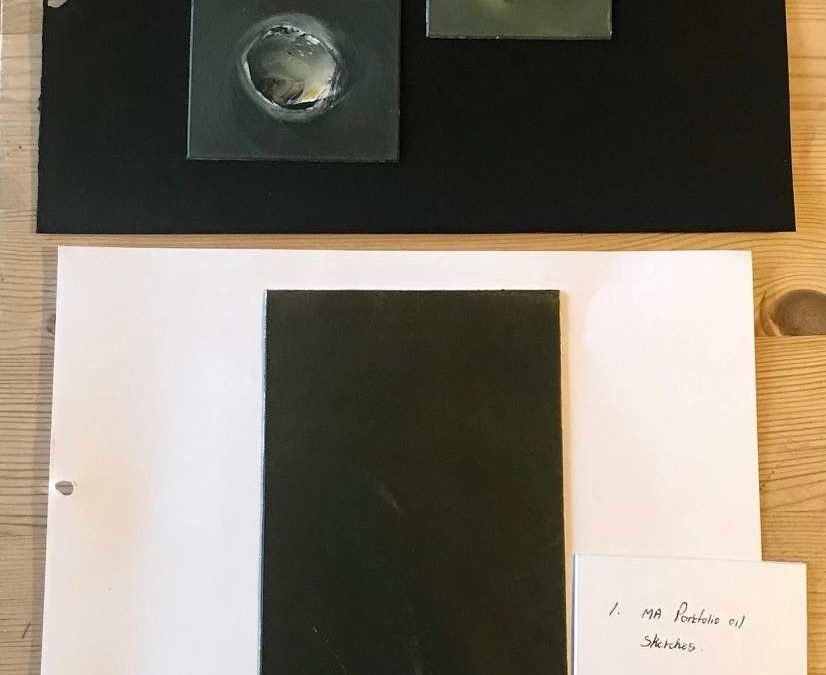I have been giving some thought about how to make the best of my crit next week. If I am to present my work to date do I want to say anything? If I say nothing the viewer will comment on the aesthetic or process and ultimately this will lead to questions about my concept. In which case I need to have something prepared to receive the useful feedback to take forward.
On a process level (practically) I have found Experimental musician and philosopher Cathleen Coussens theory on the Web of artistic practice useful. She talks about the factors which influence the creative process of making such as cultural, personal, environmental, expertise and interaction. I have considered how I may systematically impede these factors to observe how this alters my approach to materials. To date I have experimented with ways of altering my understanding or know-how by drawing and painting blind whilst responding to sound for example. I have also looked at interactions by asking another person to make marks which I then respond to and of course having a crit will itself be an interaction which may alter my process. The next stage would be to work in an unusual environment to see how this develops. I would be challenged to attempt to alter my cultural semiotic codes and personal knowledge so this could be something to discuss with the group?
I have also been reading material provided by Mark which centres around process, practice, frame and methodology. This has been very useful in helping me to position myself and have a deeper understanding as to how my practice could be describes in these individual terms. It has also given me a solid line of enquiry for research.
Chris suggested James Elkin’s ‘What Painting is’. This book uses alchemy as a way of describing the act of painting. I had no understanding of the term alchemy but understand it now to be a medieval form of primitive chemistry. It has associations with literacy and there is a magical aura around the subject. In art terms and specifically in terms of painting Elkins likens the process of experimentation and mixing earth, stones and water to crate precious elements and elixirs with the act of making a painting. Separating it from the art historians typical analysis of a painting which would focus on ‘what the painting depicts’ etc.
In the introduction Elkins describes this:
‘Neither alchemy nor painting is done with clean hands. Book-learning is a weak substitute for the stench and frustration of the laboratory, just as art history is a meagre reading of pictures unless it is based on actual work in the studio. To a non painter, oil paint is uninteresting and faintly unpleasant. To a painter, it is the life’s blood: a substance so utterly entrancing, infuriating, and ravishingly beautiful that it makes it worthwhile to go back into the studio every morning, year after year, for an entire lifetime. As the decades go by, a painter’s life becomes a life lived with oil paint, a story told in the thicknesses of oil. Any history of painting that does not take that obsession seriously is incomplete.
… Paint records the most delicate gesture and the most tense. It tells whether the painter sat or stood or crouched in front of the canvas. Paint is a cast made of the painter’s movements, a portrait of the painter’s body and thoughts. The muddy moods of oil paints are the painter’s muddy humors, and its brilliant transformations are the painter’s unexpected discoveries. Painting is an unspoken and largely uncognized dialogue, where paint speaks silently in masses and colors and the artist responds in moods. All those meanings are intact in the paintings that hang in museums: they preserve the memory of the tired bodies that made them, the quick jabs, the exhausted truces, the careful nourishing gestures. Painters can sense those motions in the paint even before they notice what the paintings are about. Paint is water and stone, and it is also liquid thought. That is an essential fact that art history misses, and alchemical ideas can demonstrate how it can happen.’ (Elkins, 2000)
Elkin’s description of painting for me is poetic as it resonates for me with how I feel about being a painter, how I view other artist’s paintings and how I see the world around me. I think that to share something of this text with the crit group would be useful in communicating my relationship with materials and describing my process as a practice led artist.
Elkins, J. (2000). What painting is. New York: Routledge, p.5.








Recent Comments